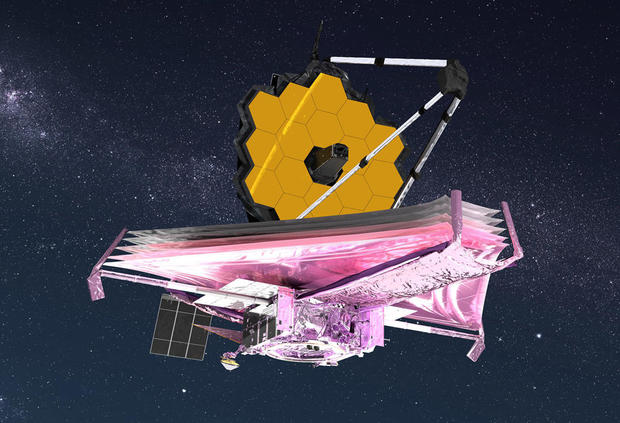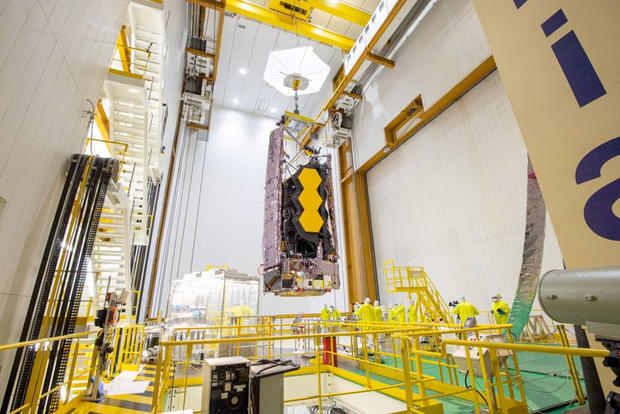The long-awaited launch of the James Webb Space Telescope, the $10 billion successor to the iconic Hubble, has been delayed at least two days. The launch will now take place no earlier than the morning of Christmas Eve as NASA works to troubleshoot a data glitch that cropped up during a pre-launch test. Folded up to fit inside the nose cone of a European Space Agency Ariane 5 rocket at ESA's launch site in Kourou, French Guiana, the telescope was mounted atop its booster on Saturday to set the stage for blastoff. Engineers were preparing to attach the protective nose cone fairing around the observatory when "a communications issue between the observatory and the launch vehicle system" was observed, NASA said in a blog post. No other details were provided other than a promise to "provide more information about the new launch date no later than" December 17. But Thomas Zurbuchen, NASA's science chief, told Spaceflight Now that the issue is "kind of an interface problem between the spacecraft and the launch system. It is a ground support equipment thing. Basically the data cables are dropping some frames (of telemetry)." That is not unusual during spacecraft testing, he said, but given Webb's astronomical price tag and its enormous value to science, "we're going to figure it out. We're not going to let anything (unexpected) stand." As a result, the Ariane 5's nose cone fairing cannot be attached before Friday, delaying launch to at least the morning of Christmas Eve, at 7:20 a.m. EST. "Tomorrow we're going up there with the ground support equipment and just really (make) sure we can flush out where the issue is," Zurbuchen told Spaceflight Now. "We've tried a bunch of things and we just haven't been successful. "This is a 100-meter cable that goes all the way from the top of the rocket to somebody's computer. Somewhere in there (is the problem) is our guess. But it's too early to say." After more than 20 years in development, multiple delays and climbing costs, NASA had hoped to launch the infrared telescope on December 18. But the flight was delayed to December 22 after a high-tension "clamp band" fitting used to attach the observatory to the Ariane 5's upper stage unexpectedly released, jostling the sensitive instrument. An engineering review found no problems and launch was reset for December 22. Engineers were testing the telescope's connections to the Ariane 5 when the latest problem was observed. The James Webb Space Telescope is the most expensive and complex science spacecraft ever built. Designed to detect the infrared glow of the first galaxies to light up after the big bang, the telescope will be launched to a parking place 1 million miles from Earth. Using a five-layer shade the size of a tennis court to block out the heat of the sun, the telescope will operate at a few degrees above absolute zero to register the faint infrared radiation left over from the initial burst of star formation. In so doing, astronomers will be able to monitor the evolution of galaxies and the role of mysterious dark matter, along with learning more about the formation of supermassive black holes like the one that resides at the heart of the Milky Way. Webb also will be used to study the atmospheres of planets orbiting nearby stars, seeking signs of habitability, while observing planets in our own solar system with unprecedented power.
Tags:
News

